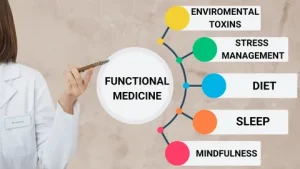
The Root Cause Revolution: How Functional Medicine Rewrites the Story of Autoimmune Disease
For decades, millions of people have lived under the weight of autoimmune diseases—conditions where the body turns against itself.

When the system failed him, he turned to what he knew best—his hands, his knowledge, and the human body’s ability to heal. After surviving a traumatic brain injury from a car accident, Dr. John W. Jung—a chiropractor with decades of clinical experience—was given a cold, clinical dismissal: “Go home and rest.” No treatment. No active care. Just silence from a healthcare system that had no plan for the days and weeks that followed trauma. But Dr. Jung was not only a patient. He was a professional, with a solid background in the science of the nervous system. And as he walked away from that hospital room, broken but determined, he decided to do what most TBI patients aren’t told they can—take healing into his own hands. His book, Alternative Treatments to TBI: What Should You Do for Brain Injury Recovery Immediately?, is both a story of survival and a hands-on guide. The main idea centers around one important but often missed therapy: chiropractic care.
Chiropractic care is frequently misunderstood. For many, it brings to mind images of back adjustments or spine cracking, disconnected from the brain entirely. But Dr. Jung reshapes that view. He reveals a stronger truth—chiropractic treatment is fundamentally about communication. It’s about restoring the body’s ability to send and receive signals through the nervous system. And in the case of a traumatic brain injury, that communication is everything. The spine houses the spinal cord, the main pathway for messages between the brain and the body. When that pathway is blocked, misaligned, or inflamed, the brain cannot perform at its best. For a TBI patient, this can mean delayed healing, foggy cognition, poor motor control, and lingering pain. Dr. Jung’s approach uses chiropractic adjustments not just to reduce physical pain but to support neurological recovery. His perspective isn’t theoretical—it’s personal. It’s lived.
As a chiropractor, he had spent years treating patients with various forms of neurological and muscular disorders. But when he became the patient, the knowledge he had once shared with others became a lifeline for himself. He returned to the foundations of chiropractic science, aligning his spine, stimulating nerves, and activating the brain through targeted physical movements. Each adjustment became a step forward—not just for his body, but for his hope. In his book, Dr. Jung explains how certain spinal adjustments can directly influence the cerebellum, the brainstem, and the cortical areas responsible for balance, memory, and coordination. Through careful observation and application, he rediscovered the power of chiropractic work when paired with sensory therapies—smell, sound, motion, and light. These therapies, when directed correctly, stimulated different hemispheres of the brain, creating new neural activity in places where trauma had silenced function.
This combination—chiropractic alignment and lateralized sensory stimulation—forms the essence of his recovery method. Its strength comes from how simple it is. It doesn’t require machines or massive hospital systems. It requires attention, intention, and a great respect for the body’s natural systems. Dr. Jung’s character in this narrative is more than inspiring—it’s instructive. He does not position himself as a miracle worker, but as a dedicated learner of his own recovery. His humility, blended with knowledge, is what makes the book feel authentic. He shares not only what worked, but how it worked. He teaches as he heals, and that makes his journey both human and helpful.
The book also emphasizes that chiropractic care should not be seen as an “alternative” in the sense of being optional or secondary. Rather, it is complementary. It works alongside other healing strategies—diet, rest, exercise, sensory input—to provide a full spectrum of support. What Dr. Jung challenges is the idea that patients should be passive in their recovery. He urges readers to think, move, feel, and act—to become participants in their own healing. One of the most powerful parts of his approach is its accessibility. The exercises and adjustments described in the book are safe and often easy to apply with guidance. For caregivers or family members, this offers a way to engage and assist meaningfully. For TBI survivors, it offers an empowering message: recovery doesn’t have to wait. Through his writing, Dr. Jung restores not only spinal alignment but something even more important—hope. Hope that the brain can rebuild. Hope that small, intentional actions can lead to big changes. Hope that even if conventional medicine tells you to “rest and wait,” you don’t have to accept that as the only truth. His knowledge into chiropractic care are not isolated from the rest of the book’s content. They’re integrated into a larger system of understanding—the idea that healing is a full-body, full-mind experience. That the body is not a collection of parts, but a web of connections. And when you restore those connections, through touch, sound, movement, and alignment, you restore life. In a medical culture often driven by pharmaceuticals and passive observation, Dr. Jung’s voice stands out. He reminds us that healing can begin with the body’s most basic tool—its structure. He invites both patients and practitioners to consider the role chiropractic care can and should play in traumatic brain injury recovery.

For decades, millions of people have lived under the weight of autoimmune diseases—conditions where the body turns against itself.

The human brain is one of the most extraordinary organs in existence—capable of adapting, learning, and healing itself in ways that science is only beginning to understand.
Sign up for Dr. John W. Jung’s newsletter and receive exclusive content on brain injury recovery, alternative treatments, and cutting-edge research. By subscribing, you’ll get expert tips on improving brain health, updates on new therapies and research findings, special offers, upcoming events, and exclusive excerpts and bonus content from Dr. Jung’s work.
Don’t miss out—join our community today!